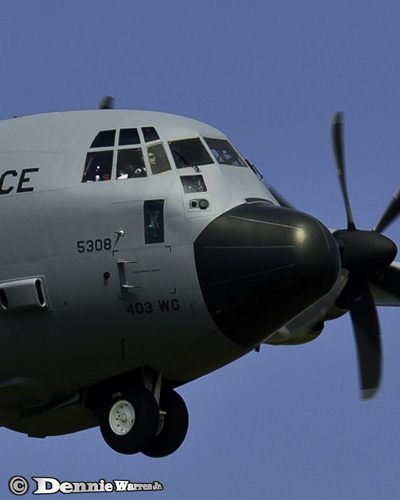Hurricane hunter pilot describes ride through eye
 (CNS): The highs and, most definitely, the lows of flying WC-130J Hercules aircraft in order to collect essential data on hurricanes were described by one of the pilots flying the essential aircraft. “It’s like being on a rollercoaster ride and in a car wash at the same time,” said Chief Pilot, Lt Col. Dave Borsi when the hurricane hunter arrived in Cayman this week as part of the NOAA awareness tour. “While the airplane can manage sustained heavy weather, even category five hurricanes, it is often smaller, disorganized systems which result in more turbulence. It can be dangerous, but that’s why we train hard. It’s all in the public’s interest.” The aircraft ride through the eyes of storms on a regular basis in hurricane season to help scientists make accurate and essential forecasts. (Photos Dennie Warren Jr)
(CNS): The highs and, most definitely, the lows of flying WC-130J Hercules aircraft in order to collect essential data on hurricanes were described by one of the pilots flying the essential aircraft. “It’s like being on a rollercoaster ride and in a car wash at the same time,” said Chief Pilot, Lt Col. Dave Borsi when the hurricane hunter arrived in Cayman this week as part of the NOAA awareness tour. “While the airplane can manage sustained heavy weather, even category five hurricanes, it is often smaller, disorganized systems which result in more turbulence. It can be dangerous, but that’s why we train hard. It’s all in the public’s interest.” The aircraft ride through the eyes of storms on a regular basis in hurricane season to help scientists make accurate and essential forecasts. (Photos Dennie Warren Jr)
Borsi explained that as the aircraft heads into a storm, pilots slow to about 200 miles per hour to allow by-the-second gathering of compressed data. It’s that data which is essential to the forecasters. The NOAA team, who visited Cayman on Wednesday, said showing off the aircraft is an important element in the awareness campaign. Hurricane Hunter missions cover a vast area – from the Atlantic to Hawaii – and crews often simultaneously track several storms.
 National Hurricane Centre (NHC) in Miami Director Bill Read explained that no one else in the world flies these reconnaissance airplanes. “Their overseas visits serve to demystify their work, while encouraging leaders and others to keep hurricane preparedness at the forefront,” he said. “By using the Hurricane Hunters’ readings regarding the size, intensity and structure of wind fields, the NHC can improve track forecasting by about 15 percent.”
National Hurricane Centre (NHC) in Miami Director Bill Read explained that no one else in the world flies these reconnaissance airplanes. “Their overseas visits serve to demystify their work, while encouraging leaders and others to keep hurricane preparedness at the forefront,” he said. “By using the Hurricane Hunters’ readings regarding the size, intensity and structure of wind fields, the NHC can improve track forecasting by about 15 percent.”
Read also commented on the long-standing relationship with Cayman and NHC and said he was delighted with the success of the recent 33rd Session of the Region IV Hurricane Committee co-hosted by Cayman and the World Meteorological Organisation.
Cayman Islands National Weather Service Director-General Fred Sambula and Hazard Management Cayman Islands Director McCleary Frederick expressed their appreciation of the visit this week, which attracted wide public attention. “This is critical to enhancing public awareness and education in the areas of hurricane preparedness and mitigation,” Sambula added.
It seemed that everyone from school kids to governors were keen to have a look-see at the Hurricane Hunter on Wednesday afternoon as many people took advantage of the Hercules aircraft tour and the chance to speak with crew members while it was landed at Owen Roberts International Airport.
Category: Science and Nature


Nuff respect to the hurricane hunters and God speed in their mission and much gratitude to the service which is provided to all in the Caribbean basin and beyond.
heroes, simple as that.
The career of a MAN MAN!
I was lucky enough to have a walk through the plane with my 5 year old son, and it was a great experience for both of us. The crew members were very friendly and answered any questions that people had.
CSI, did you ask per chance if they allow Beavers on the plane? Soon enough you’ll be building a new dam… LOL The Beaver